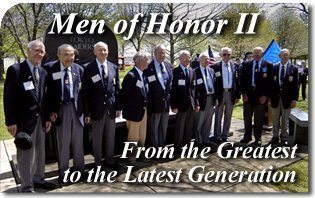 “For those who fought for it,” said an unknown soldier, “freedom has a meaning the protected will never know.”
“For those who fought for it,” said an unknown soldier, “freedom has a meaning the protected will never know.”
A collection of military giants who fought for freedom convened in Washington, D.C. for the 14th Annual Veterans Conference, put on by the American Veterans Center. Soldiers, Marines, Sailors and Airmen from the greatest to the latest generation were on hand to tell their stories and be honored for their service.
These men from conflicts beginning with World War II up to the current war in Afghanistan have contributed to the demise of the cruelest tyrants and the most despotic regimes of the twentieth and twenty-first centuries. It is appropriate for us to take a moment this Veterans Day to reflect on their sacrifices.
Wounded Warriors
Among those who spoke were wounded warriors like SSgt. Jeremiah Workman. He earned a Navy Cross during the Battle for Fallujah when he entered a house to save some Marines who were pinned down by terrorists on the upper floor. Sgt. Workman charged into the house, and ran up the stairs firing on the enemy, dodging bullets as he went. When he realized that the rest of his squad was not with him, Workman was forced to retreat, but only long enough to regroup his men and make a second charge up the staircase with guns blazing.
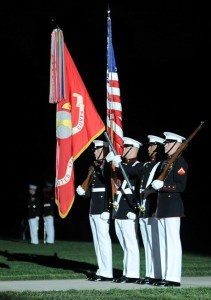
Marine Barracks, Washington, D.C.
Running low on ammunition, the Marines went back down the steps to reload when a terrorist lobbed a grenade in their direction. In spite of the painful shrapnel wounds to his legs and the intensity of the fight he was now engaged in, Sgt.
Workman was undeterred. He led a third and final assault up the stairs where he was able to secure the house. He was credited with killing 20 enemy combatants.
While he survived the hellish battle, other Marines did not.
This was the most difficult thing for him to endure and led to a painful struggle with Post Traumatic Stress Disorder (PTSD). The Navy Cross, he says, has allowed him to bring attention to many great Marines who did not survive that day.
Steve Maguire, former President of the Ranger Association and author of Jungle in Black was also on hand to tell his story. He lost his eyesight during a battle in Vietnam where he stumbled upon an area where 30 Vietcong had just been. He saw their impressions in the grass and realized he hit “pay dirt.” Because of his keen military training he also perceived a booby trap awaiting them. One of his fellow Rangers inadvertently tripped the wire that set off an explosion which left Mr. Maguire blind. For 42 years he has not seen a speck of light but remains upbeat, even philosophical about his experiences.
“I thought I was invincible,” he told a rapt audience, but with a smile on his face he added, “I was forced to admit, that they could actually kill me.” There is a future for those wounded in battle, he told the audience. “The story of our life is not just about our life, but what we did with it.” Mr. Maguire went on to earn a doctorate in psychology and did so because he never allowed himself to wallow in self-pity.
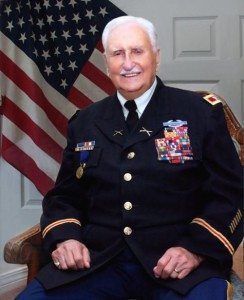
Hell’s Guest1
One of the most colorful personages at the Conference was Col. Glenn Frazier. He survived the infamous Bataan Death March and was quick to admit, had he known what was in store for him, he would have preferred death to the march.
He joined the Army when only sixteen and did so under amusing circumstances. He was in a bar having a Coca-Cola one day when the bartender rudely told him to leave.
“You boys from Lowndes County are always beating up the boys from Montgomery County,” he said. Although he was only sixteen he took his Harley Davidson, drove it through the front doors of the saloon with such violence it ripped the doors off their hinges, sending them into the air and on top of the bar. He then did a figure eight on the dance floor before leaving.
Frustrated with life, he went straight to the Army recruiter to join the military. Since his mother had refused to sign for him, he lied about his age and said he was twenty one. After giving him the list of options of where he could go, the recruiter told him that the Philippines were a paradise. He would find out, all too soon, another side of that “paradise.”
After the bombing of Pearl Harbor, his unit endured a savage fight against Japanese forces in the Battle of the Points. It was predicted by the enemy that the Americans would be destroyed in 10 days, but when the dust settled, Allied forces were victorious. But the worst was yet to come when he and 15,000 other soldiers were taken prisoner and forced to endure one of the most grueling tortures in our nation’s history, The Bataan Death March. Three thousand died during the march and only 4000 came home after the war.
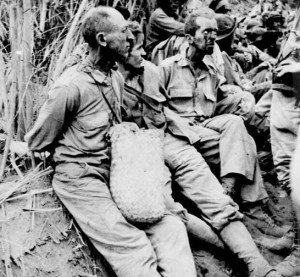
Although he survived the March, he then had to endure three years in a POW camp where he was continually told by his captors that he was merely a “guest of the Emperor.” Col. Frazier thought otherwise and wrote about his struggles in a bestselling book titled Hell’s Guest. Living on merely two bowls of rice a day, he said they were treated like animals in the most inhumane conditions.
One day he suffered a severe cut on his hand which went to the bone. It was so cold and he was so emaciated that the wound did not bleed.
Some days later he was walking across the camp with his hands in his pocket, to keep warm, and quickly found out that this was against the rules. He was taken before a judge and sentenced to death, but was saved by a miracle of God. With a gun to his back and a saber to his throat, his assassin asked Col. Frazier if he had anything to say before his head was cut off. He was then given, as he recalled “a mouth and wisdom.”2
“You can kill me but not my spirit,” he told the stunned Japanese soldier, “and my spirit is going to lodge in your body and haunt you the rest of your life.” A frown came over the face of his would be assassin who took three steps backwards and lowered his sword. Whether it was fear of God or pagan superstition, he decided it might not be a good idea to kill this American serviceman. Instead Col. Frazier was forced to endure seven days of solitary confinement and more brutal beatings.
However, his spirit lived on and continues to inspire young Americans across the country. Colonel Frazier can be seen daily at Battle Ship Park in Mobile, Alabama signing his books.
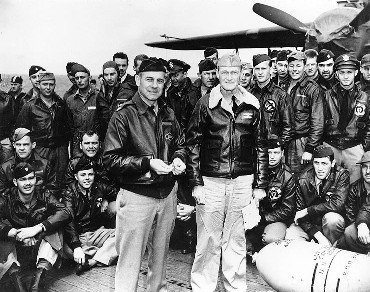
by other members of the Raiders prior to the raid on Tokyo.
The Doolittle Raiders
One of the highlights of the conference events was the panel that included four of the last five living members of the legendary Doolittle Raiders, named after their founder and Medal of Honor Recipient, the late Gen. Jimmy Doolittle.
These men earned a place in history books for their participation in one of the most heroic actions of World War II. After the bombing of Pearl Harbor, Gen. Doolittle was handed the task of conducting the first retaliatory air raid on the Japanese homeland. The eighty men asked to participate were told that it was a very dangerous mission and would entail low altitude bombings on targets that were to remain top secret. Everyone in the room volunteered.
In the weeks leading up to the raid, the pilots practiced for the mission by flying tree-top-level over the wheat fields and barns across America. In the earlier days of April 1942 they made their way to the USS Hornet where 16 B-25s awaited them. Because the planes could not fit below deck they had to be stored at the end of the runway top side. This meant that an already short 2000 feet runway was made shorter still at 500 feet, especially for those like Gen. Doolittle who took off first.
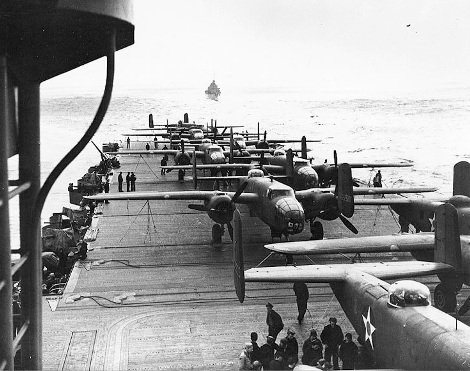
One can only imagine their surprise on that bright sunshiny day, April 18, 1942, when the Raiders were finally told that Tokyo, Japan was their intended target.
The original plan was for the planes to take off when the carrier got within 450 miles of the Japanese mainland. This was scientifically calculated by Gen. Doolittle as the distance which would allow them enough fuel to hit their targets and make it to mainland China where they would land at pre-designated air strips. An already complicated mission was made more so when the USS Hornet was spotted by a Japanese fishing boat 600 miles off the Japanese mainland. Not wanting to risk the possibility that Japan might have already been warned by that boat, Gen. Doolittle ordered the planes airborne, 150 miles ahead of what had been planned. The pilots knew they would have barely enough fuel to make it to China much less to the pre-designated air strips.
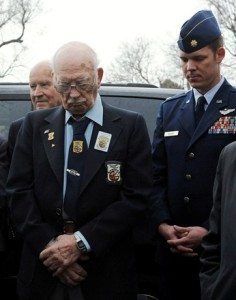
Major Edward Saylor, an engineer for plane #15 said he “didn’t expect to survive the mission.” But the element of surprise was something he found delicious.
Major Thomas Griffin, the navigator aboard plane #9, described how he flew right over Emperor Hirohito’s palace. They were ordered not to bomb it “but the fly over was the least we could do,” he said with a smile. He made it safely to China but only because of a favorable tail wind. During his flight he described with a bit of humor how he was forced to think of a contingency plan in the case he would have to ditch it in the sea.
“I would try to land near a friendly ship,” he said, and if it were an unfriendly he added with bravado, “we would take it over with our 45’s.” One of the fellow Raiders sitting close by laughed and said, “Optimistic thinking.”
Of the sixteen original B-25s on the mission, three crash-landed on the coast of China, while twelve flew until they ran out of fuel before the airmen bailed out. The last plane was forced to land in Russia.
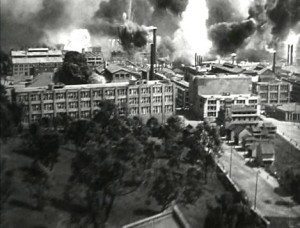
The value of the raid can only be truly appreciated when one considers that the Japanese did not think their land would be bombed. Besides giving the enemy what one Raider referred to as a “black eye,” the Doolittle Raid changed the whole course of the war because it required the Japanese to change their mindset. They were forced to retain soldiers for the defense of the home islands which had been intended for the Solomons, but they also had to expand the Pacific perimeter of defense well beyond what they had formally thought to be adequate.3
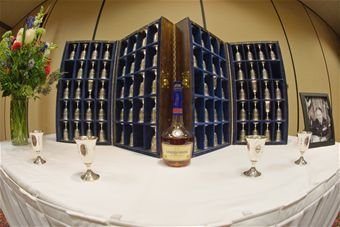
Goblet Ceremony
At the 1959 Raider Reunion in Tucson, Arizona, the Chamber of Commerce presented a set of eighty sterling goblets to General Doolittle with the name of each Raider engraved on the side. The Raiders who had already died had their names engraved upside down. At every reunion since then the raiders keep up the tradition started on that day. They turn the goblets of those who have died over and then toast their heroism.
The eighty goblets are preserved in an elegant glass trophy case4 along with a bottle of 1896 Cognac donated by Hennessy to honor the year of Gen. Doolittle’s birth. The tradition of the yearly toast will end with the last two remaining Raiders still standing. Only then will the bottle of Cognac be opened and a final toast offered by the last two men of this historic group.5
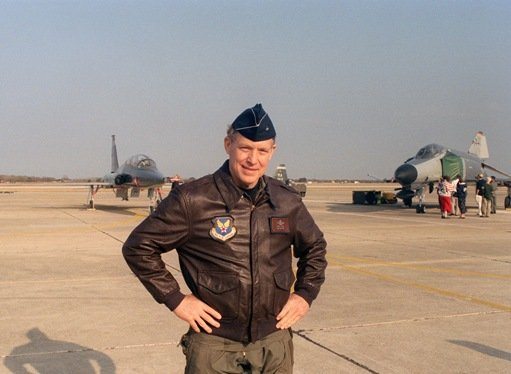
Only “Ace”6 Pilot in the Vietnam War
Another piece of living history and a highlight of the conference as well, was the presence of Gen. Steve Ritchie, one of the most highly decorated pilots of the Vietnam War. After distinguishing himself on his first tour of duty in Vietnam, General Ritchie volunteered for a second tour in 1972 and earned a place in aviation record books that will likely never be equaled.
On May 10 of that year he shot down a Russian MIG 21 and then another on May 31. Weeks later he engaged and destroyed two more MIGs in a classic low altitude dogfight which lasted just 89 seconds. On August 28, he shot down a fifth MIG during his 339th combat mission making him the Air Forces only “Ace” pilot since the Korean War and the only American pilot in history to down five of the most sophisticated aircraft in the North Vietnamese fleet.
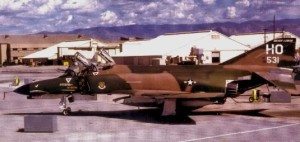
under the cockpit for enemy kills.
His list of accolades is simply astounding. Besides receiving the Air Force’s highest award — the Air Force Cross — he went on to earn four Silver Stars, ten Distinguished Flying Crosses and 25 Air Medals. Before his career ended in 1974, he had logged more than 800 flying hours.7
During his talk he illustrated all too well that he knows the enemy at home as well as the enemy he fought abroad.
“Never have we, in America, faced such a dangerous threat,” he said, “which is determined as never before to either convert us or eliminate us and we are not even allowed to say the name of our enemies.”
“They can saw off our heads and put it on television all over the world,” he said, quoting the conservative radio commentator Paul Harvey, “yet we have to tiptoe around their sensitivities.”
“Whether we like it or not,” he finished, “we are in combat and it is a war of good vs. evil, right vs. wrong, freedom vs. slavery, civilization vs. chaos.”
The Little American Flag: Hope of a Romanian Girl

Photo courtesy of Chris Graham.
After thrilling the audience with his adventurous war stories and inspiring them with his perspectives, he turned the microphone over to his Romanian born wife Mariana. She briefly described what it was like, as a little girl, living under Communism in her homeland. As a five-year-old, she remembered having to wait hours in line for such basic things as bread or even water. The word God was not allowed and although her grandfather was a priest, she was threatened for going to church.
The number one enemy of the Communists, she told the audience, was America. It is for this reason that she had hopes of one day being rescued by someone from the United States. One day she saw a picture of an American flag inside a magazine that had been smuggled into the country. She cut that picture out and drew enormous comfort just looking at it.
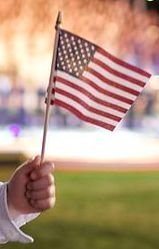
A Symbol of Hope.
“I used to take it out and stare at it for a long time,” she said, “sometimes for hours. I was dreaming about America and what it must be like to be free.”
One day she decided to take her flag to school, where children were subjected to Communist indoctrination, and got caught. Although the teacher was furious and threatened to punish Mariana for having the flag, they could not find where she hid it.
“I could afford to lose my life,” she continued, “I could care less. But one thing I could not do is go on living without hope and that little American flag was all I had that kept me going.”
Her dream was that American pilots would go to Romania and blow it up, level it.
“Whatever they needed to do in order to free us: even if I were to die in the process, so be it. It was a price we [Romanians] would have gladly paid in exchange for freedom. We would have given the Americans anything; the oil in southern Romania; the gold in the mountains; our life and soul in exchange for freedom.”
She finished her words by thanking America for everything, including a “second chance at life,” but also for “giving me a home and teaching me new words like happiness, honor and kindness.”
Whereas most little girls dream of a knight in shining armor, riding a white horse this Romanian girl’s ideal was clearly a twentieth century version. “I dreamed of an American fighter pilot who would rescue me with his fighter jet,” she said, “and take me to America.”
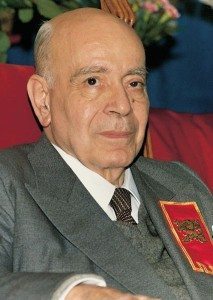
Those Who Fight for Freedom
This burning desire for freedom of a little Romanian girl, left unheeded for years, reminded me of a favorite phrase from a stirring manifesto written by the “Twentieth Century Crusader,”8 Prof. Plinio Corrêa de Oliveira titled, Communism and Anticommunism on the Threshold of the Millennium’s Last Decade.9 It was a scathing denunciation against those in the West who remained silent about the millions of souls languishing behind the former Iron Curtain.
In it, Prof. de Oliveira described the discontent of those people in countries like Romania and what they would say when it came their time to speak. He imagined them questioning Western historians who “wrote optimistically and superficially about what was happening in the Communist world,” yet chose to say so little about the immense misery. Or the wealthy public figures of the West who did so little to free them from the “dark and endless night of Soviet Slavery.”
“We needed a Crusade to free us,” Prof. Plinio imagined the discontent saying, “and you merely sent us some bread to help us endure indefinitely our captivity. Perchance were you ignorant that the best solution for captivity is not merely bread, but freedom?”
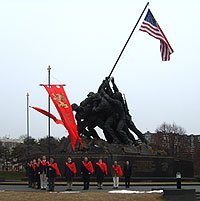
That is the reason why, on this Veterans Day, we should remember all those American servicemen who, like modern day crusaders, fought and continue to fight for the defenseless. They do not remain with crossed arms in the face of so much infamy but put their lives on the line, time and time again, for those who are often abandoned by the rest of the world.
This no doubt is what led Mariana Ritchie to finish her discourse with something that seldom makes it into print, but needs to be plastered on the walls of every newspaper office in the country.
“You are not hated, like some people like to say. You are loved by millions of people who are hoping that someday you will go and rescue them next.”
Footnotes
- http://hellsguest.com/
- From the gospel of St. Matthew.
- http://www.doolittleraider.com.
- Today the goblets can be seen at the National Air Force Museum in Dayton Ohio located at Wright-Patterson Air Force base.
- Ibid.
- Ace designates a pilot who has shot down five or more enemy planes.
- http://www.af.mil/information/heritage/person.asp?dec=&pid=123006498.
- Title of the first biography about Prof. Plinio Corrêa de Oliveira written by Prof. Roberto de Mattei.
- https://tfp.org/tfp-home/statements/communism-and-anticommunism-on-the-threshold-of-the-millenniums-last-decade.html.

